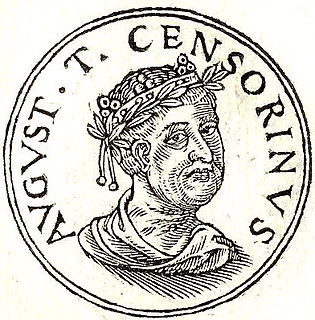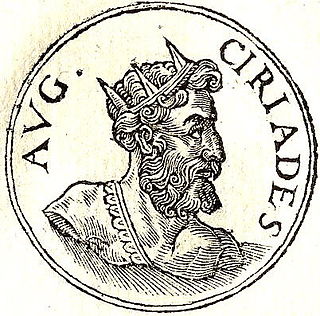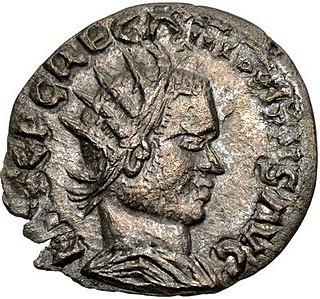 W
WAureolus was a Roman military commander and would-be usurper. He was one of the so-called Thirty Tyrants who populated the reign of the Emperor Gallienus. Of humble Daco-Roman origins, he was 'made' by the Emperor Gallienus and proved himself to be one of the most brilliant and innovative soldiers of the age. However, he later turned against his benefactor, and was destroyed in the political turmoil that surrounded the Emperor's assassination in a conspiracy orchestrated by his senior officers. The ancient sources which refer to Aureolus are limited and the information they do provide is often contradictory. They include the Historia Augusta, Zonaras' epitome and Zosimus' Historia Nova. His career was most recently summarised in John Bray's biography of Gallienus. The analysis of Aureolus's career given here, especially his final rebellion, is largely based on Bray.
 W
WTitus Cornelius Celsus, supposedly a Roman usurper, who rebelled against Gallienus. He was one of the so-called Thirty Tyrants enumerated by Trebellius Pollio. His historicity is doubted by some scholars, who consider him an invention of the Historia Augusta.
 W
WAppius Claudius Censorinus was a fictional usurper against Roman Emperor Claudius II, according to the unreliable Historia Augusta. He is included in the list of the Thirty Tyrants.
 W
WCyriades was a Roman rebel who betrayed the city of Antioch to Shapur I sometime during the 250s. His chief claim to fame is that he is enumerated as one of the Thirty Tyrants who supposedly tried to overthrow the emperor Gallienus.
 W
WSeptimius Herodianus or Hairan was the son and co-king of Odaenathus of Palmyra. Through his father's marriage to Zenobia, Hairan had two half brothers, one with the same name, Hairan II, and Vaballathus.
 W
WIngenuus was a Roman military commander, the imperial legate in Pannonia, who became a usurper to the throne of the emperor Gallienus when he led a brief and unsuccessful revolt in the year 260. Appointed by Gallienus himself, Ingenuus served him well by repulsing a Sarmatian invasion and securing the Pannonian border, at least temporarily. Ingenuus had also been charged with the military education of Caesar Cornelius Licinius Valerianus, the young son of Emperor Gallienus, but after the boy's death in 258, his position became perilous.
 W
WVictorinus Junior was a fictional usurper who was claimed to have risen up against the Roman Emperor Aurelian, according to the Historia Augusta. He is included in the list of the Thirty Tyrants.
 W
WUlpius Cornelius Laelianus was a usurper against Postumus, the emperor of the Gallic Empire. His revolt lasted from approximately late February to early June 269.
 W
WMaeonius, or Maconius, was a short-lived Roman usurper.
 W
WFulvius Macrianus, also called Macrianus Major, was a Roman usurper. He was one of Valerian's fiscal officers. More precisely, sources refer to him as being in charge of the whole state accounts or, in the language of a later age, as Count of the Treasury and the person in charge of markets and provisions. It seems almost certain that he was an Equestrian. The Historia Augusta claims that he was the foremost of Valerian's military commanders, but that is most likely a gross exaggeration, if not entirely fictitious.
 W
WMarcus Aurelius Marius was emperor of the Gallic Empire in 269 following the assassination of Postumus.
 W
WTitus Fulvius Iunius Macrianus, also known as Macrianus Minor, was a Roman usurper. He was the son of Fulvius Macrianus, also known as Macrianus Major.
 W
WLucius Mussius Aemilianus signo Aegippius who held a number of military and civilian positions during the middle of the third century. He is best known as a Roman usurper during the reign of Gallienus.
 W
WSeptimius Odaenathus was the founder king (Mlk) of the Palmyrene Kingdom who ruled from Palmyra, Syria. He elevated the status of his kingdom from a regional center subordinate to Rome into a formidable state in the Near East. Odaenathus was born into an aristocratic Palmyrene family that had received Roman citizenship in the 190s under the Severan dynasty. He was the son of Hairan, the descendant of Nasor. The circumstances surrounding his rise are ambiguous; he became the lord (ras) of the city, a position created for him, as early as the 240s and by 258, he was styled a consularis, indicating a high status in the Roman Empire.
 W
WPiso was probably a Roman general whom the imperial pretender Macrianus Major sent to suppress the governor of Achaia, Valens Thessalonicus. His existence is attested only by the unreliable Historia Augusta, which labels Piso as one of several usurpers who plagued the reign of Emperor Gallienus. While some historians grudgingly regard Piso as a historical figure, many reported details of his life, including his usurpation, are dismissed as fabrications.
 W
WMarcus Cassianius Latinius Postumus was a Roman commander of Batavian origin who ruled as Emperor in the West. The Roman army in Gaul threw off its allegiance to Gallienus around the year 260, and Postumus assumed the title and powers of Emperor in the provinces of Gaul, Germania, Britannia and Hispania, thereby founding what scholars have dubbed the Gallic Empire. He ruled for the better part of ten years before he was murdered by his own troops.
 W
WIn the Historia Augusta, Postumus the Younger figures as one of the so-called Thirty Tyrants who usurped power against the Roman Emperor Gallienus. According to the pseudo-historical list of 'Thirty Tyrants', the Emperor of the Gallic Empire Postumus had a son, also called Postumus, whom he nominated to be first caesar, and later even augustus and co-ruler. Postumus the Younger would have been killed together with his father in 268, during the rebellion of Laelianus.
 W
WTitus Fulvius Junius Quietus was a Roman usurper against Roman Emperor Gallienus.
 W
WP. C. Regalianus, also known as Regalian, was Roman usurper for a few months in 260, during the Crisis of the Third Century, a period of intense political instability in the Roman Empire. Regalianus was acclaimed emperor by the troops along the Danube river, a region of the empire that frequently experienced barbarian raids, probably in the hope that he might be able to secure the frontier.
 W
WGaius Pius Esuvius Tetricus was the emperor of the Gallic Empire from 271 to 274. He was originally the praeses (governor) of Gallia Aquitania, and became emperor after the murder of Emperor Victorinus in 271, after receiving the support of Victorinus's mother Victoria. During his reign, he faced external pressure from Germanic raiders, who pillaged the eastern and northern parts of his empire, and the Roman Empire, from which the Gallic Empire had seceded. He also faced increasing internal pressure, which led him to declare his son, Tetricus II, caesar in 273 and possibly co-emperor in 274, although this is debated. The Roman emperor Aurelian invaded in 273 or 274, which culminated in the Battle of Châlons, at which Tetricus surrendered. Whether this was the result of a secret agreement between Tetricus and Aurelian or necessary after his defeat is debated. Aurelian spared Tetricus, and even made him a senator and corrector (governor) of Lucania et Bruttium. He died of natural causes a few years after 274.
 W
WGaius Pius Esuvius Tetricus was the son of Tetricus I, Emperor of the Gallic Empire (270-274).
 W
WValens Thessalonicus was a Roman usurper during the reign of Emperor Gallienus.
 W
WTitus is one of the Thirty Tyrants, a list of Roman usurpers compiled by the author(s) of the often unreliable Historia Augusta. Titus was said to have revolted against Maximinus Thrax, a Roman Emperor who ruled 235-238, after the revolt of Magnus. It is now believed that his biography is fictitious, and that he may be based on person named Quartinus mentioned by the historian Herodian.
 W
WTrebellianus was a Roman usurper listed among the thirty tyrants in the Historia Augusta. Modern historians consider this figure a character invented by the author of Historia, whose traditional name was Trebellius Pollio.
 W
WVictoria, also known as Vitruvia, was a leader in the Roman breakaway realm known as the Gallic Empire in the late 3rd century. She was the mother of Victorinus, who ruled as Gallic Emperor until his assassination in 271. Afterwards, Victoria used her authority to stabilize the empire and select a successor.
 W
WMarcus Piavonius Victorinus was emperor in the Gallic provinces from 268 to 270 or 269 to 271, following the brief reign of Marius. He was murdered by a jealous husband whose wife he tried to seduce.
 W
WSeptimia Zenobia was a third-century queen of the Palmyrene Empire in Syria. Many legends surround her ancestry; she was probably not a commoner and she married the ruler of the city, Odaenathus. Her husband became king in 260, elevating Palmyra to supreme power in the Near East by defeating the Sassanians and stabilizing the Roman East. After Odaenathus' assassination, Zenobia became the regent of her son Vaballathus and held de facto power throughout his reign.